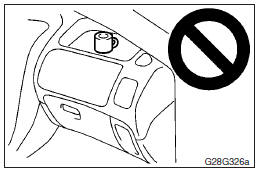Deployment of front air bags

The front air bags ARE DESIGNED TO DEPLOY when...
The front air bags are designed to deploy when the vehicle suffers a moderate to severe frontal impact. Typical conditions are shown in the illustration:
1- Head-on collision with a solid wall at a speed of approximately 25 km/h (15
mph) or higher
2- Moderate to severe frontal impact within the shaded area between
the arrows
The front air bags will deploy if the severity of the impact is above the designed threshold level, comparable to an approximately 25 km/h (15 mph) collision when impacting straight into a solid wall that does not move or deform. If the severity of the impact is below the above threshold level, the front air bags may not deploy. However, this threshold speed will be considerably higher if the vehicle strikes an object that absorbs the impact by either deforming or moving (for example, another stationary vehicle, pole or a guard rail).
Because frontal collisions can easily move you out of position, it is important to always properly wear your seat belts. Your seat belts will help you to keep a safe distance from the steering wheel and instrument panel during the initial stages of air bag deployment. The initial stage of air bag inflation is the most forceful and can possibly cause serious or fatal injuries. Moreover, the seat belts in your vehicle are your primary means of protection in a collision. The SRS (Supplemental Restraint System) air bags are designed to provide additional protection. Therefore, for your safety and the safety of all occupants, be sure to always properly wear your seat belts.

The front air bags MAY NOT DEPLOY when...
With certain types of frontal collisions, the vehicle’s body structure is designed to absorb the shock to help protect the occupants from harm. (The vehicle body’s front area may deform significantly as it absorbs the impact.) Under such circumstances, the front air bags may not deploy irrespective of the deformation and damage to the vehicle body. Examples of some typical conditions are shown in the illustration:
1- Collision with a utility pole, tree or other narrow object
2- Vehicle slides
under the rear body of a truck
3- Oblique frontal impacts
Because the front air bags do not protect the occupant in all types of frontal collisions, be sure to always properly wear your seat belts.

The front air bags ARE DESIGNED NOT TO DEPLOY when...
The front air bags are designed not to deploy in conditions where they cannot typically provide protection to the occupant. Such conditions are shown in the illustration:
1- Rear end collisions
2- Side collisions
3- Vehicle rolls onto its side
or roof
Because the front air bags do not protect the occupant in al types of frontal collisions, be sure to always properly wear your seat belts.

The front air bags MAY DEPLOY when...
The front air bags may deploy if the bottom of the vehicle suffers a moderate to severe impact (undercarriage damage). Examples of some typical conditions are shown in the illustration:
1- Collision with an elevated median/island or curb
2- Vehicle travels over
a deep hole/pothole
3- Vehicle drives down a steep slope and hits the ground
Because the front air bags may deploy in certain types of unexpected impacts as shown in the illustration that can easily move you out of position, it is important to always properly wear your seat belts. Your seat belts will help you to keep a safe distance from the steering wheel and instrument panel during the initial stages of air bag deployment. The initial stage of air bag inflation is the most forceful and can possibly cause serious or fatal injuries if you contact it at this stage.

WARNING
(1) Do not attach anything to the steering wheel padded cover, such as
trim material, badges, etc. It might strike and injure an occupant if the air bag
inflates.
(2) Do not set anything on or attach anything to the instrument panel
above the glove box. It might strike and injure an occupant if the air bag inflates.
(3) Do not attach accessories to or put them in front of the windscreen. These objects
could restrict the air bag inflation or strike and injure an occupant if the air
bags inflate.
(4) Do not put packages, pets or other objects between the air bags
and the driver or front passenger. It could affect air bag performance or could
cause injury when the air bag inflates.
(5) Right after the air bag inflation,
several air bag system components will be hot. Do not touch them; you could be burned.
(6) The air bag system is designed to work only once. Once the air bags have deployed,
they will not work again. They must promptly be replaced and the entire air bag
system inspected by an authorized MITSUBISHI dealer.
(7) If the vehicle is involved
in a frontal collision but the air bags are not inflated, have the air bag system
checked and, if necessary, replaced by an authorized MITSUBISHI dealer.
See also:
Cruise control
Cruise control is an automatic speed control system that keeps a set speed. It
can be activated at about 40 km/h (25 mph) or more.
CAUTION
• When you do not wish to drive at a set speed, turn o ...
During cold weather
The capacity of the battery is reduced at low temperatures. This is an inevitable
result of its chemical and physical properties. This is why a very cold battery,
particularly one that is not full ...
Outside temperature display screen
This shows the temperature outside the vehicle.
Note
► The display setting can be changed to the preferred units (°C or °F).
Refer to “Changing the function settings (when the ignition ...
